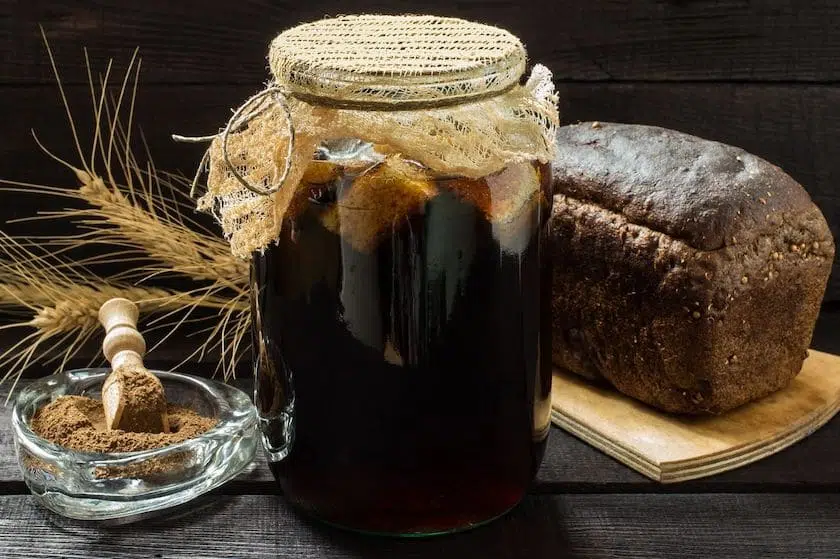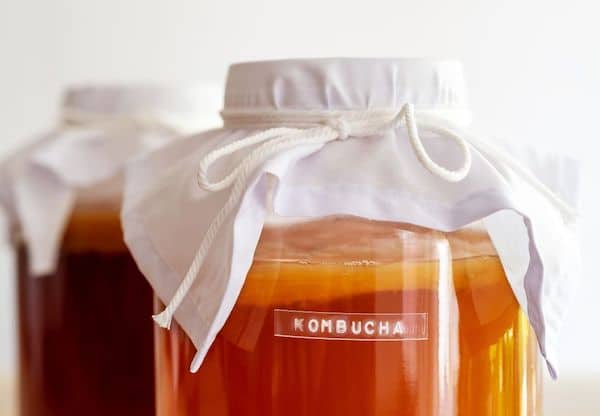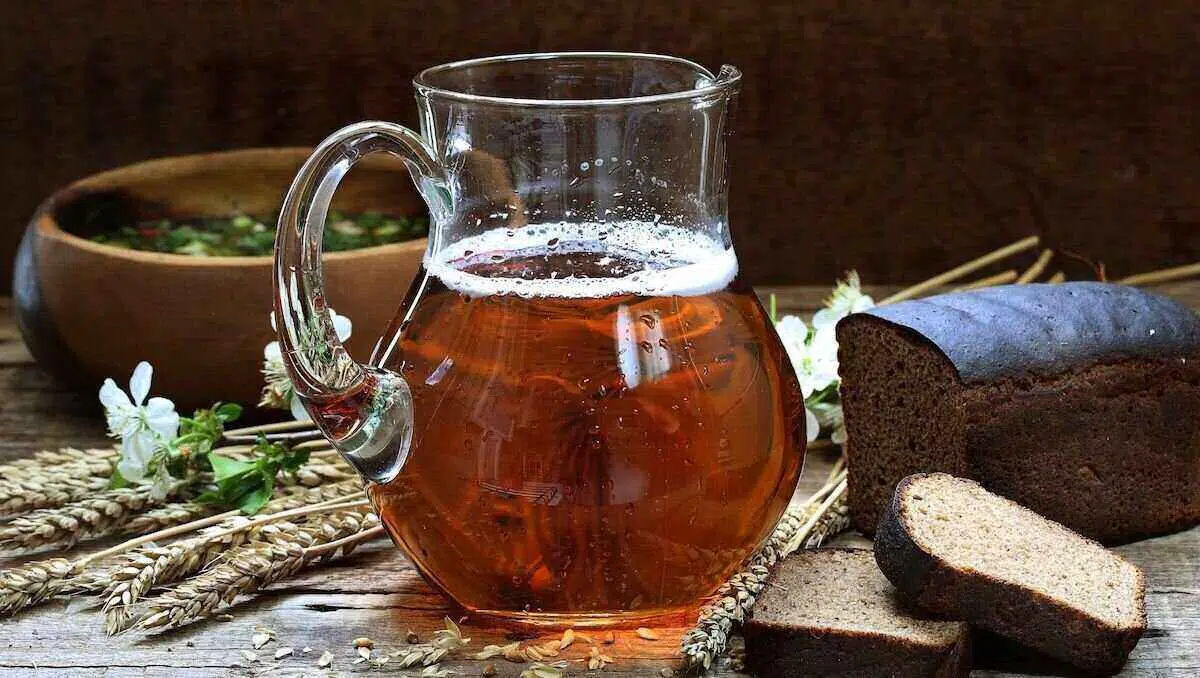Kvass, sometimes also spelled Kvas, is a Russian grain drink with a low level of alcohol. The traditional, fermented refreshment is produced from Russian wheat, rye bread, and beets. The result is a sweet drink with notes of toasted bread and a slightly tangy bite. Not only is Kvass delicious, but it is also healthy and very nutritious.
Yet the best about the fermented drink is that you only need a few things to make it. -Some leftover bread and a small set of additional ingredients to initiate fermentation.
Jump To Recipe | What is it? | Ingredients | How to make it? | Which Yeast? | Duration of fermentation | Add flavor to the recipe | Tips to make it better | Is it good for your body? | History | Kvass vs. Kombucha | FAQs

Ingredients
- 2.5 Gallons Water
- 9 Slices Classic black, dark, or rye bread
- 1 Handful Raisins
- 4 cups Sugar
- 1.5 tbsp Active dry yeast
Instructions
- Fill a large (or better extra-large) pot with the water and bring to a boil. If you do not own one that is large enough, split it up into two.
- Toast each slice of bread two times. Make it really dark, as this will affect the color of the final product. And darker Kvass looks more appealing 😉
- Once the water boils, remove the pot from your stove and add the raisins together with the toasted bread.
- Cover it with a lid and let it rest for at least 8 hours.
- Remove the toasted bread.
- Mix sugar and yeast, add them to the pot and stir the whole mix.
- Cover it up again for another 6-8 hours. Stir the mix every once in a while.
- Strain the mixture into bottles with the help of a fine-mesh strainer or cheesecloth. Close the bottle caps loosely and refrigerate overnight.
- You can seal the bottles tightly the morning after.
Nutrition
What is Kvass?
Kvass is a traditional low-ABV fermented drink, most famous in Russia and Eastern Europe. Usually, you use leftover bread (bread kvass), but you can also make it from beets (beet kvass) or even fruits (fruit kvass).
It has a sweet taste, comparable to honey, but with malty and bready notes; the flavor is probably best compared with malt beer. Due to the fermentation process, the beverage has a light carbonation and a low amount of alcohol.
Homemade Kvass typically contains anywhere between 0.5% to 2.5% alcohol by volume. Commercial products like Imperial Kvas often contain more, about up to 4% ABV.
Ingredients
Depending on which type of Kvass you want to make, the list of ingredients is different. In our case, it will be Bread Kvass from old rye bread, water, a sweetener like honey, and yeast.
To spice things up and add more flavors, you can extend the recipe with spices, herbs, fruits, and other sweeteners.
- Bread: It can be black, dark, or even sourdough rye bread. Bread is the base of the fermented drink and defines how the result tastes. To prepare the bread for fermentation, cut it into cubes and toast the chunks until they darken.
- Sweetener: The sweetener also adds flavor to our Kvass, but its real purpose is to help feed the bacteria and the yeast starter culture. For this, you can use ordinary sugar but also honey or molasses.
- Yeast starter culture: This helps to kick-start the fermentation process. It inoculates the bread with yeast lactobacillus bacteria and helps to ferment the drink in a safe way.
- Additional flavorings: By adding spices to the mix, you can alter the taste to your liking. You can also add herbs or fruits. Common ingredients are cinnamon, apple, pears, coriander, or berries.

Make Bread Kvass - Step by Step
If you want to make Bread Kvass, you have to follow four basic steps. The whole process takes quite a while, but the amount of work you need to put in is limited.
Altogether, you will only spend a few minutes prepping the fermentation and another few bottling and preparing the "bottle conditioning".
Yeast and good bacteria do the rest of the work, which turns your old, stale bread into a bubbly and alcoholic beverage.
- Prepare ingredients: This step is all about the bread. Cut it into smaller pieces, then toast them in the oven until they darken.
- Soak the bread: In the next step, we soak the toasted bread in water. On average, this takes up to 3 days. You can speed up the process by using boiling water.
- Fermentation: After one day, carefully remove the bread from the mix. Then, add your sweetener and yeast to get the initial fermentation started.
- Bottling and conditioning: After the initial fermentation, strain the slightly fermented Kvass into bottles with a cheesecloth. Store the bottles in the fridge and cover them only loosely. Once they're chilled, you can seal them.
Which Yeast to Use?
Our recipe works with instant yeast. To kick off fermentation, Kvass requires a starter culture. You can use a sourdough starter, but also baker's yeast or ordinary bread yeast is fine.
When you want to replace instant yeast with something else, you need to adjust the measurements accordingly:
For example, brewer’s yeast is more active. Therefore, you need way less to get the same results. For our recipe, half a tablespoon would be enough.
Here's an overview of the different yeast options to make Kvass and how they can affect the final product.
- Commercial yeast, or baker's yeast, is widely available. It is interchangeable with active dry yeast - the most common choice for baking.
- Brewer's yeast is more active. That means that you should use less to achieve the same results.
- A Sourdough starter is another great option if you can get it. These starters combine lactobacillus bacteria and yeast, which also affects the taste of your homemade Kvas and makes it fizzier.
- You can use wild yeast, also called fruit yeast, to start the fermentation. You can obtain it by soaking fruit in water for a few days. The yeast in the fruits will multiply, making it a great starter.
- A Ginger bug starter is made from organic, unpeeled ginger, sugar, and water. It's often used for probiotic sodas but is not a classic choice for making Kvass. If you use it in your recipe, be prepared for a light ginger flavor in your drink.
- Kvass itself can also function as a starter. The sediment is full of yeast and accumulates at the bottom of your bottles. That makes it easy to collect for starting your next batch.

How long to ferment
Our general indication: the process should take between 2 and 7 days. After 48 hours, you can taste it and check the carbonation. It should already be a bit sour with a hint of sweetness.
Homemade Kvass is all about balancing flavor and fizz. You want to let it ferment long enough to get that sourness and carbonation without letting it get overly sour.
Traditionally, carbonation is relatively low. Yet, because we are getting more used to strongly carbonated beverages, the traditional version would not taste right.
The longer you ferment the Kvass, the more tangy its flavor will be. So taste regularly to avoid an overly sour result. Once it tastes right, filter it through a fine-mesh strainer and bottle it.
Add Flavor
Our Kvass recipe includes raisins to add a bit of flavor and additional sweetness. But there are plenty of other ways to bring flavor to your drink, from herbs to spices to fruits.
- Raisins: Our preferred option brings a subtle and sweet nuance to the drink and also helps with fermentation. Other dried fruits like cranberries work, too.
- Mint: Adding fresh mint to the mix will create a more refreshing drink with a hint of menthol. An alternative option is lemon verbena to combine the fresh taste with citrussy notes.
- Apples or pears: Fresh and chopped apples or pears will add a fruity touch to Kvass. Alternatively, you can also use them to make fruit kvass.
- Beets: You can make beet-based Kvass, but you also can add them to your bread kvass recipe to give it an earthy sweetness.
- Herbs: Another great way of flavoring Kvass is the addition of herbs. Dandelion or pine needles, for instance.
- Berries: Last but not least, a few fresh berries can add beautiful sweet, tart, and fruity notes to the drink.
Tips & Tricks to Improve the Result
The whole process of making Kvass is pretty straightforward. If you follow the steps in our easy recipe, you can easily make it at home. Still, we have a few tips that will improve the quality of your homemade Kvass.
- The right choice of bread: sourdough rye bread is fine, but a darker or classic black bread works best.
- Properly toast the bread: You can toast the bread in the oven or use a toaster. As a rule of thumb, with a toaster, you will need two rounds of toasting. If you opt for the oven, closely watch your bread and remove it before it burns.
- Use hot water: This will help speed up the process of fermentation, plus it's the traditional way of making Kvass. The water does not need to be boiling hot. 160°F to 185°F (about 70°C to 85°C) is just right.
- The sweetener: We use regular sugar, but you can also use honey, molasses, or a rich sugar like Demerara. Avoid non-caloric sweeteners like saccharin and steviol glycosides. They don't contain enough carbohydrates to feed the bacteria.
- Warm environment: If you can ensure a warm environment, the fermentation of your Kvass will be much faster. When working in conditions below room temperature, adjust the resting times.
- Extra carbonation: If you want your drink to be fizzier, add a bit of extra sugar once you bottle your Kvass. Approximately 1/2 tsp per 500ml already makes it a lot more bubbly.
Is Kvass Good for You?
Like other fermented beverages such as Kombucha or Tepache, Kvass is rich in nutrients and a great source of beneficial bacteria. Here's a quick overview of the health benefits associated with drinking Kvass:
- A fantastic probiotic: Probiotics are known to improve gut microbial flora, which is good for our intestinal tract and overall immune system. [1]
- Rich in nutrients: The beverage is also a great source of manganese, vitamin B12, and various minerals like copper, selenium, zinc, iron, and magnesium. [2]
- Microbial variety: The mix of microbes in Kvass varies from recipe to recipe. But overall, the drink is known to contain a variety of microbes that also support your gut and overall health system. [3]
- Beneficial during pregnancy: The high amounts of vitamins like B6 and B12 in Kvass can help the fetus grow and reduce the chances of morning sickness. Yet, please discuss this with your doctor first. [4]
The History
The origin of Kvass is a lot older than Russia itself. The first written evidence goes back more than 1,000 years. Location-wise, the recipe traveled from Ancient Egypt, Babylon, and Greece all the way to what is known today as Russia. That was long before Vodka or the Cyrillic alphabet was invented.
Back then, people already knew about the healing qualities of the beverage. The fact that it was safer than water made it an everyday drink for everyone, even kids.

It may sound odd by today's standards, but back then, it was a natural solution to compensate for the lack of clean water and also a way to reduce food waste:
Boiled water was poured over old and stale bread, and its high temperature killed many pathogenic bacteria, which potentially could make people sick.
Additionally, during fermentation, the lactic acid bacteria convert sugar into lactic acids, acetic acids, and carbon dioxide. These compounds help fight pathogens and make food and drink even safer for consumption.
In the 1700s, fermented Kvass was the most popular beverage for people from all social classes in Russia. It was part of daily life.
In the 1900s, the love for the fermented drink still was so great that it got the name communist Coca-Cola, linking Kvass to the most famous American refreshment.
While kids in America used to line up in front of ice cream trucks on hot summer days, Russian kids lined up for another refreshment - Kvass. At times when sodas and soft drinks were rare, that was a real treat.

Kvass vs. Kombucha
Kombucha and Kvass are both lactic acid-based fermentations. While the probiotic benefits of are pretty similar, the two beverages still are very different.
For instance, while Kvass can have various base ingredients, Kombucha offers only one option - sweetened black tea. Also, when making Kombucha, you need a specific starter culture called ‘SCOBY’.
Scoby stands for Symbiotic Colony Of Bacteria and Yeasts. That consists of a mixture and balance of strains, very specific for creating Kombucha.
Further, the fermentation duration is quite different. While Kvass needs between 2 - 7 days, Kombucha usually takes 5 - 30 days of fermenting at room temperature.
FAQs
Yes, just like other fermented beverages such as Kombucha and Tepache, Kvass does contain a low amount of alcohol. -Typically between 0.5% to 2.5% ABV.
Theoretically, yes. However, you would need to drink enormous amounts of homemade Kvass to get drunk.
Bread kvass, the most common type, is made of rye bread, thus, not gluten-free. But you can make gluten-free fruit kvass or beet kvass instead.
Stored in the fridge, homemade Kvass will keep for one week (7 days). Commercially produced Kvass lasts significantly longer.
Especially with Bread Kvass, you want to store the bottles in the fridge. That ensures that it lasts for up to one week.
If your Kvass turned bad, you usually are able to see it. If you see any signs of mold or slimy texture or are greeted by a weird smell when opening the bottle, discard it.
Usually not. But as with any fermented drink, Kvass produces carbon dioxide during fermentation, which increases pressure in bottles and jars. If you do not open them now and then, your vessels could potentially burst.
No, the color and the slight carbonation could make you think it is some sort of beer, but it is not. Kvass is a fermented drink like Kombucha or Tepache.
The taste of Kvass is best compared to malt beer: sweet with a malty and bready flavor and a slightly bitter note.
There are many popular Kvass Brands and the best-known are Põrgu Kali, Ochakovsky, Jester King, and Fonta Flora.


I've never made kvass before but it turned out to be quite tasty. Thanks for the easy to follow recipe guys